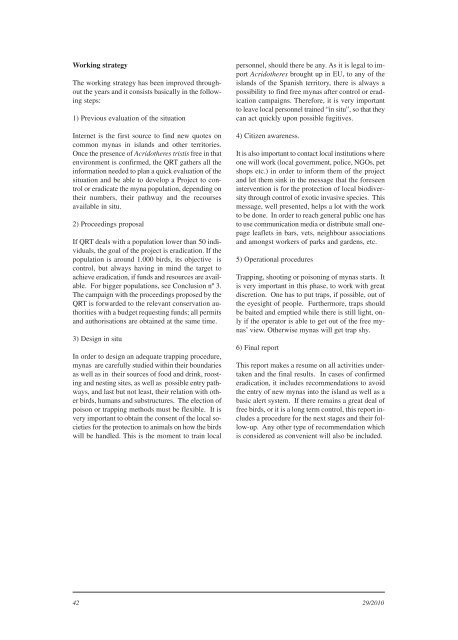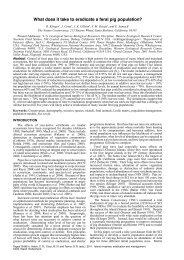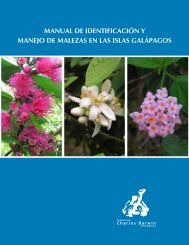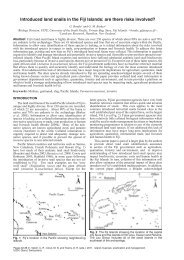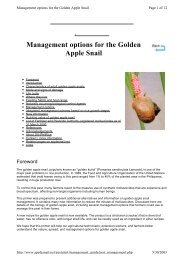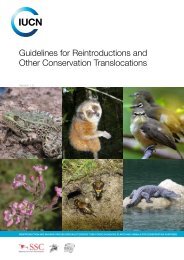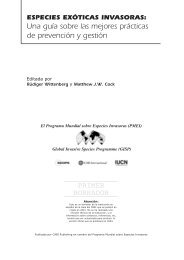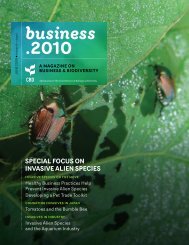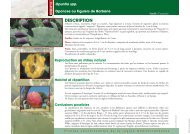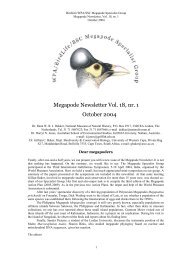Aliens Newsletter - ISSG
Aliens Newsletter - ISSG
Aliens Newsletter - ISSG
Create successful ePaper yourself
Turn your PDF publications into a flip-book with our unique Google optimized e-Paper software.
Working strategy<br />
The working strategy has been improved throughout<br />
the years and it consists basically in the following<br />
steps:<br />
1) Previous evaluation of the situation<br />
Internet is the first source to find new quotes on<br />
common mynas in islands and other territories.<br />
Once the presence of Acridotheres tristis free in that<br />
environment is confirmed, the QRT gathers all the<br />
information needed to plan a quick evaluation of the<br />
situation and be able to develop a Project to control<br />
or eradicate the myna population, depending on<br />
their numbers, their pathway and the recourses<br />
available in situ.<br />
2) Proceedings proposal<br />
If QRT deals with a population lower than 50 individuals,<br />
the goal of the project is eradication. If the<br />
population is around 1.000 birds, its objective is<br />
control, but always having in mind the target to<br />
achieve eradication, if funds and resources are available.<br />
For bigger populations, see Conclusion nº 3.<br />
The campaign with the proceedings proposed by the<br />
QRT is forwarded to the relevant conservation authorities<br />
with a budget requesting funds; all permits<br />
and authorisations are obtained at the same time.<br />
3) Design in situ<br />
In order to design an adequate trapping procedure,<br />
mynas are carefully studied within their boundaries<br />
as well as in their sources of food and drink, roosting<br />
and nesting sites, as well as possible entry pathways,<br />
and last but not least, their relation with other<br />
birds, humans and substructures. The election of<br />
poison or trapping methods must be flexible. It is<br />
very important to obtain the consent of the local societies<br />
for the protection to animals on how the birds<br />
will be handled. This is the moment to train local<br />
personnel, should there be any. As it is legal to import<br />
Acridotheres brought up in EU, to any of the<br />
islands of the Spanish territory, there is always a<br />
possibility to find free mynas after control or eradication<br />
campaigns. Therefore, it is very important<br />
to leave local personnel trained “in situ”, so that they<br />
can act quickly upon possible fugitives.<br />
4) Citizen awareness.<br />
It is also important to contact local institutions where<br />
one will work (local government, police, NGOs, pet<br />
shops etc.) in order to inform them of the project<br />
and let them sink in the message that the foreseen<br />
intervention is for the protection of local biodiversity<br />
through control of exotic invasive species. This<br />
message, well presented, helps a lot with the work<br />
to be done. In order to reach general public one has<br />
to use communication media or distribute small onepage<br />
leaflets in bars, vets, neighbour associations<br />
and amongst workers of parks and gardens, etc.<br />
5) Operational procedures<br />
Trapping, shooting or poisoning of mynas starts. It<br />
is very important in this phase, to work with great<br />
discretion. One has to put traps, if possible, out of<br />
the eyesight of people. Furthermore, traps should<br />
be baited and emptied while there is still light, only<br />
if the operator is able to get out of the free mynas’<br />
view. Otherwise mynas will get trap shy.<br />
6) Final report<br />
This report makes a resume on all activities undertaken<br />
and the final results. In cases of confirmed<br />
eradication, it includes recommendations to avoid<br />
the entry of new mynas into the island as well as a<br />
basic alert system. If there remains a great deal of<br />
free birds, or it is a long term control, this report includes<br />
a procedure for the next stages and their follow-up.<br />
Any other type of recommendation which<br />
is considered as convenient will also be included.<br />
42 29/2010


